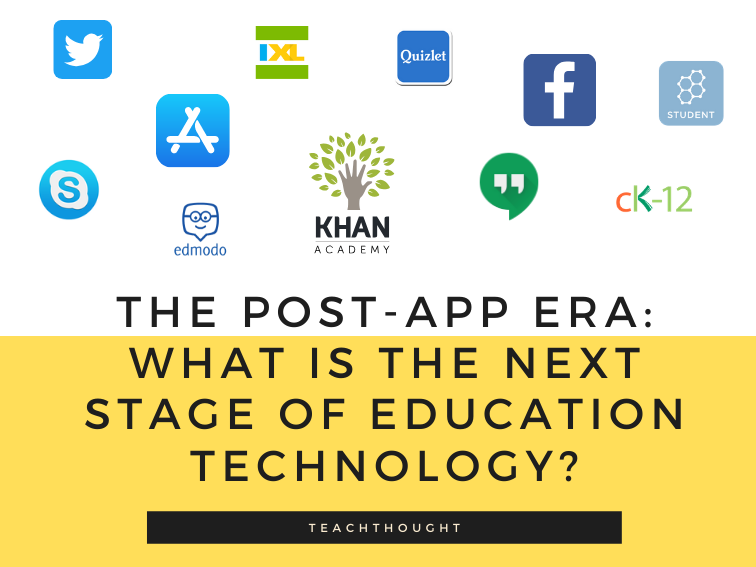
The Post-App Era: What Is The Next Stage Of Education Technology?
What are the stages of education technology?
Obviously mobile technology dominates the most recent trends and mobile applications–or apps–have served an important role in the evolution of what’s possible in a classroom. Libraries and textbooks and teachers have been the traditional portals to information in education. This had many benefits, including a very even, aligned, and uniform learning experience for students.
Like apps, textbooks are solutions to the challenge of organizing content for study. They package curriculum, and allow the teacher to focus on controlling the pace and navigation of the curriculum. But books, while credible and convenient, are also closed, dated, non-fluid, generalized, unengaging, and depend heavily on the reading level of the user.
This is where apps came in. They fractured content into countless interesting fibers so that ‘Math’ became twenty-four expertly-curated YouTube channels, a gamified and flexible site in the form of the Khan Academy, games to support game-based learning in math, and a smaller handful of adaptive apps that adjust themselves on-the-fly to student performance.
This has been a critical step because it has decentralized and democratized where information comes from. This ‘opening’ of content areas has dozens of consequences, but few are more important than the ability to turn over content creation to actual human beings again.
We’ve talked about learning playlists and even how apps can replace textbooks. Take a YouTube channel like Smarter Every Day. (See below.) It’s impossible to create a textbook—or any book—that can match the authenticity, diversity, and engaging nature of these videos. The same with so many of the apps we share here at TeachThought.
For pure academic learning, IXL, CK-12, Nearpod, Class Dojo, Google Classroom, and dozens of others are fantastic.
The Problem With The App Era Of EdTech
But a few years into this iPad-led frenzy, the app phase started showing its age. Many apps were mediocre, abandoned, or broken. Some were clear money-grabs with little content area expertise behind them. Some of the business models weren’t sustainable. Others seemed to have been written by people who have either never seen a child in their life, or know nothing about teaching and learning.
Unsurprisingly, while there have been many success stories that have lifted education, overall it all produced underwhelming results.
So what’s the next stage of education technology? Ideally, a ‘post-app’ era in edtech would be characterized by blended learning, meaningful data integration, authentic and student-centered social collaboration, and genuine mobility in communities native to the learner. Curriculum, assessment, and instruction would communicate seamlessly with one another, and with communities native to the student.
So far, the growth of education technology has been limited, in part, because of missing #edtech leadership at the school, district, and state level. The expertise, experience, and vision is absent–which leads to more purchasing and policies than inspiration and design.
The Next Stage Of Education Technology
The next phase of education technology should focus then not on the technology, but on areas of convergence between students, communities, content, and technology. ‘Blended’ learning, if you will. This will require a broader scope of vision than we’re used to, but it should yield suitably revised ways of learning strategies (e.g., learning through play), content forms (e.g., video, apps, student peer-to-peer networks, etc.), and education goals (truly personal and student-centered learning experiences for every student, every day).
Education is suffering not just from a lack of edtech leadership, but a lack of frameworks and systems that ‘accept’ technology. The next stage of #edtech–and apps can be a big part of this–has to be smarter than the ‘solutions’ we’re currently settling for, or they’re not solutions at all.
Apps and tablets are only ‘better’ than textbooks and plastic binders if they are part of a system of learning that’s been clean-sheet designed for them to work together.
If we only need content sequenced and packaged for universal consumption, a textbook is miles better than an iPad or Google Classroom-centered Chromebook.
Twitter is only slightly better than a bullhorn if you’re only reaching out to people you already know.
Content, learning, and technology each must be designed in such a way that they are aware of one another. One ‘part’ works seamlessly to inform and reform the other. It all should be in a constant state of flux and borderline chaos. This makes current education systems–including many large corporations driven by profit and not learning–uncomfortable.
While students gravitate towards it, and many teachers are intrigued, education technology is an alien thing in the average curriculum map or instructional unit. The next era in education technology–an era of adaptivity personalization and blending convergence–will arrive when this is no longer true.
The question is, can education stomach the disruption?
This post was updated from a 2016 post by the author
What’s Wrong With Education Technology?